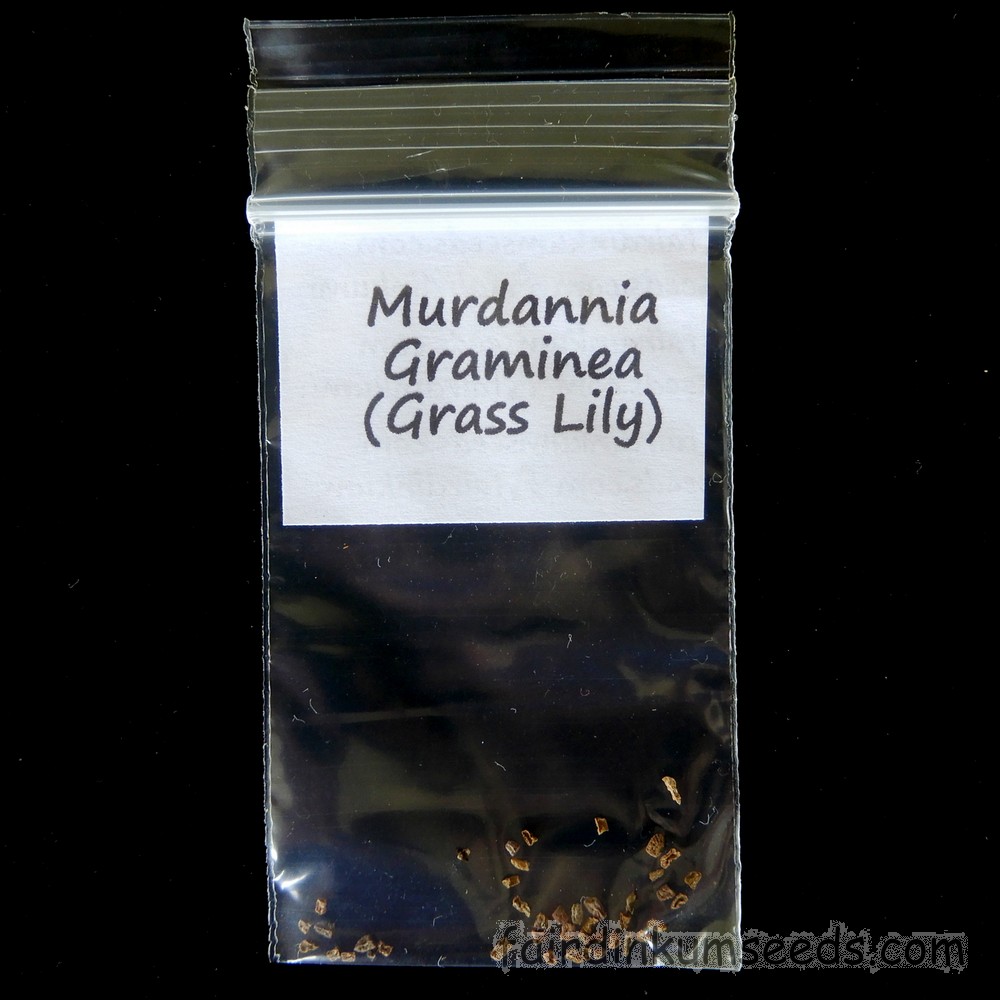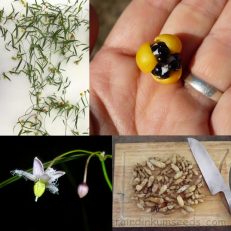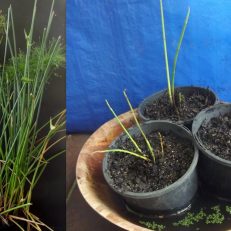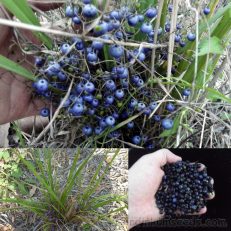Please read text!
Murdannia Graminea Grass Lily Seeds
Packet of 10+ seeds from this awesome native tuberous vegetable!
I have always eaten these guys when cruising around the bush, and they are a very reliable bushtucker.
That said, it took me ages to work out how to grow them at home as a productive food crop too.
In nature they are small fleshy onion or grass like plants that produce a lovely pink and purple flower every Summer.
They grow small edible tuberous roots that easily detach from the main stem and look a lot like fingers on a hand. The main picture on the right hand side shows a couple freshly harvested wild plants as an example.
They taste bland and can be fibrous in harsh dry conditions, but even so they are never offensive or bitter.
Just kinda boring, especially when eaten raw.
Cooking them gives them a more potato like flavour, but it also makes them a bit tougher.
Not bad at all, just nothing special is all and not that much off each plant.
3 small plants is a decent meal in the bush.
BUT, if you grow them in good conditions, nice loose sandy soil, give them the odd water and a bit of compost, they do much much better.
Those Tuberous Roots are food storage only from what I can gather, and if you remove them from the mother plant they won’t grow into a new plant unless there is a bit of central stem attached.
Even if you do carefully split the plant into 2 or 3 pieces down the middle of the stem it stunts them and slows the growth heaps.
It’s a slower start, but it works out much better in the end to just let the single plant mature, then plant all the seeds it produces.
You get more kilos of tubers in less time at the end of the day.
So yeah, very different to more common imported crops like sweet potato or spuds.
That’s a decent way to get a decent crop, but it’s still not awesome.
So, after a few years of trials this is what I have come up with.
This is the way I maximise the yields, and produce larger tastier tubers all at the same time.
What I suggest you do is buy seeds from me(of course), then plant them.
Then when they mature, flower and set seeds, you plant the 100’s of seeds they produce.
As soon as you have done that you can get your first small harvest!
Each plant can be dug up carefully and all the outside tubers can be carefully twisted off by hand.
I say twisted not cut with a sharp knife, because when you cut them they lose more moisture.
Twisting crushes the tissue making the sap clot and in a side by side trial there was a small but noticable difference in recovery and survival rates.
Make sure to leave each plant with at least 3 tubers in the middle firmly attached to the central stem. If there is any doubt, leave more not less as being greedy now, means less later.
You can then replant the harvested plants and the stress of the exercise will cause the plant to either immediately flower again, in which case you get another few dozen seedlings to plant.
Or it will put all it’s energy into producing more tuberous roots.
This is the most common response, pretty much 90% of the time here for me.
This time those roots will be longer, straighter, thicker and less fibrous.
They look completely different as you can see in the picture.
From then onwards they can be harvested and replanted every ~4months.
The picture of the ones in the bowl are the tubers I grow here at home and they are about twice as thick and long as the ones I get from the local bush.
I just fried a few up like chips for the picture, but I also eat them sliced in salads, added to stews and curries, pretty much any time you use a carrot or a potato you can substitute these guys instead.
How do they taste you ask?
Well, the flavour is basically nothing.
It’s not bitter, or sour, or starchy, or slimey, or anything really.
Think pontiac potato, but less starchy and somehow blander?
They don’t need peeling and the shiny thin pale yellow skin washes very clean very easily, just with a quick rinse under a tap.
If that’s not good enough for you, then you can soak the washed roots over night in the fridge.
The next day just giving them a quick rough rub with your hands is enough to completely remove the skin leaving the pure white flesh underneath. No need to use a peeler or whatever.
I don’t bother same as I don’t bother with traditional potatoes and carrots either, but it’s your call and you can if you want. It’s super easy compared to other crops.
While that description of “bland and inoffensive” doesn’t sound great it really is, because there is nothing at all to hate about them.
They taste of bugger all and have a nice texture, and because of this they go great with absolutely everything!
As is just deep fried with a bit of chicken salt it’s just like chips and this “blandness” really is just versatility in disguise.
Unlike many of our more strongly flavoured bush foods, these guys could easily find their way into mainstream cooking and even the fussiest of kids shouldn’t have a drama with them.
After all, what’s to hate?
They are the beige of the vegetable world and we all know that despite being boring beige IS one of the most popular colours, it’s everywhere you look.
To my eye maybe production has been the limiter, and now I reckon I have that pretty sorted.
All you have to do is grow a crop, rip up the plants, remove the outside tubers and replant the mother plants again.
In my experience this can be done at least 3x a year without effecting the plants in any way that I can see.
As they still flower and set seeds around those main plants every Summer, and they handle transplanting very well, once established a crop is semi-selfsustaining, with volunteer seedlings just being removed and replanted into the places where the odd plant doesn’t survive a particularly rough harvest.
It’s more labour intensive and manual, unlikely to ever be automated, but it’s quick easy work, and only has to be done 4x times a year.
That’s a lot less work than most other more common crops.
Add a bit of selection here and there over a decade or two and there is even more potential.
I personally always cull out the bottom 10% that is smaller, slower, or if there is ever any insect issues and with this and the continual sexual reproduction the plants just get better generation after generation.
This is how we turned pencil sized white runted roots into the massive orange carrots we know today, and these guys are off to a much better start.
It handles pretty much all of Australia being native to WA, NT, QLD, NSW, and surely it could be grown further south too, at least as an annual in the warmer months.
It looks pretty and handles full sun or even quite heavy shade and a huge range of soils though like most root crops it does produce better looking tubers in soils that are loose moist and fine grained.
I reckon it’s awesome, and I really reckon we should throw some $ at developing it as a food crop.
In the meantime I am happy to just eat it raw as a bush-tucker when wandering around the scrub, or cooked as a vegetable here at home.
If you want to have a crack yourself now you know where to get some seeds.
Germination is easy, just sprinkle the seeds on sandy soil and water in well.
They look a lot like grass or onions to start with so make sure you don’t forget you planted them and weed them out a few months later by mistake!
Wish I could say I hadn’t done that before, more than once…
Grown by me and the Mrs organically, no chems, no nasties, no problems!!!





